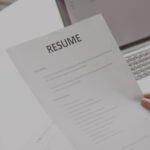Robbing Peter to Pay Paul: The Resume Trap in Hiring
By Admin

Why exaggeration in one area and underplaying another can cost candidates the right role.
Introduction
There’s an old phrase — “robbing Peter to pay Paul.” It usually refers to taking resources from one area to cover for another, creating imbalance instead of solving the real problem. The same principle applies to resumes. Too often, candidates overemphasize certain skills while underplaying others, unintentionally distorting their professional story. The result? They either land jobs they don’t truly want, or get overlooked for roles they’re actually qualified for.
The Trap of Overemphasis
Imagine a candidate with strong project management skills who decides to highlight them excessively because “that’s what employers want right now.” They fill their resume with jargon about Agile, sprint cycles, and roadmaps. But in doing so, they bury equally important capabilities — say, client communication or technical expertise.
An interviewer reading this resume might think: “Impressive project management, but that’s not what we’re hiring for.” The candidate ends up in an interview for a role misaligned with their true strengths.
This is robbing Peter (their communication skills) to pay Paul (their project management emphasis).
The Danger of Understatement
On the flip side, many candidates fall into the trap of understatement. They’ve mastered multiple tools or led significant projects but describe them modestly, as though they’re just “part of the job.” While honesty is critical, underrepresentation is also a form of dishonesty — it prevents interviewers from seeing the full picture.
An interviewer doesn’t read between the lines. They read what’s on paper. If your resume downplays your capabilities, it tells them you might not have those skills at all.
The Interviewer’s Lens
It’s important to remember: interviewers aren’t looking for a perfect candidate, they’re looking for the right one. When reading a resume, they subconsciously ask:
- Does this person’s story align with the role?
- Are they inflating a niche skill at the expense of a bigger picture?
- Am I seeing balance, or bias?
A well-balanced resume answers those questions clearly without leaving room for doubt.
Finding the Balance
The key is honesty with precision. That means:
- Highlighting strengths relevant to the role without burying others.
- Using metrics and results to show impact, not just listing skills.
- Making sure your resume reflects your career narrative, not just job descriptions.
Robbing Peter to pay Paul in a resume creates imbalance — and interviewers notice it. Instead, think of your resume as a mirror: it should reflect your true self, not a distorted version.
Conclusion
Hiring is about fit, and resumes are the doorway. When you overplay one hand and underplay another, you risk mismatching yourself to the wrong opportunities. The most successful resumes strike balance — they showcase both depth and breadth without distortion.
At MatchPoint Solutions, we help candidates and companies align skills with opportunities, ensuring resumes and roles connect seamlessly.
The Importance of Being Earnest: Lessons for Hiring
By Admin

What a witty Victorian play can teach us about honesty in the workplace
Introduction
Oscar Wilde’s The Importance of Being Earnest is often remembered as a witty comedy about mistaken identities, social pretenses, and the irony of being “earnest.” But beyond the laughter, the play holds timeless lessons about honesty, self-representation, and integrity—values that deeply resonate with modern hiring practices.
The question Wilde pokes at—what does it mean to be truly earnest?—is one hiring managers and job seekers alike must ask themselves today.
Lesson 1: Don’t Play a Role You Can’t Sustain
In the play, characters adopt false identities to escape responsibilities or win affection. It works temporarily, but the truth always comes out. Similarly, in hiring, candidates who exaggerate or misrepresent their skills may land a role—but will struggle to keep it.
For employers, the lesson is just as sharp: selling a role as more flexible, glamorous, or growth-filled than it really is will only drive turnover later. Both sides lose when “acting” replaces authenticity.
Lesson 2: Understatement Can Be Just as Misleading
Interestingly, Wilde’s comedy isn’t just about overstatement—it’s also about characters hiding aspects of their identities. The same applies to resumes and interviews. Many candidates underplay their strengths, leaving out capabilities because they assume they’re “not important enough” or “too minor.” But omission can distort the picture just as much as exaggeration.
For recruiters, this means reading between the lines—using AI-powered tools and human intuition to spot undervalued skills or transferable strengths.
Lesson 3: Earnestness Builds Trust
At its heart, Wilde’s play shows how relationships unravel without honesty. The same truth applies in hiring: trust is the foundation of every good match. Candidates who present their skills authentically are more likely to find roles where they thrive. Employers who are transparent about expectations, culture, and growth opportunities are more likely to retain talent long-term.
AI can help validate resumes, benchmark skills, and reduce bias, but it cannot replace human conversations that test for values, intent, and sincerity. A hybrid model—AI efficiency plus human empathy—ensures earnestness is rewarded.
The Final Act: Honesty is a Two-Way Street
In Wilde’s world, the characters’ tangled lies eventually collapse under their own weight, and only honesty restores order. In hiring, the stakes may not be theatrical, but they’re just as real: careers, growth, and futures are on the line.
Being earnest—whether you’re a job seeker or an employer—is not just about avoiding lies. It’s about presenting the whole picture. Not too much, not too little. Because at the end of the day, the best hiring decisions, like the best relationships, are built on truth.
Is Your Resume Outdated—Or Just Misrepresented?
By Admin

Introduction
The question isn’t always “Do I have the skills?”—often, it’s “Am I showing them right?”
In hiring, perception is as important as reality. You could be exceptionally qualified but still lose out because your resume hides your strengths behind outdated formats or misplaced focus. Sometimes, it’s not that your career needs a refresh—it’s that your resume does.
The Silent Career Killer: Underrepresentation
Many job seekers believe being “modest” on a resume is noble. The result? Your core strengths get buried under generic bullet points.
Consider this:
- You led a major project that saved your company millions but wrote it as “assisted in cost-reduction efforts.”
- You mastered a new AI tool but tucked it into the “other skills” section.
If you underplay your achievements, recruiters won’t magically know the full story—they’ll just move on.
When Outdated Presentation Becomes the Problem
The content of your resume matters, but so does how it looks and reads.
Signs your resume is dated:
- Dense paragraphs with no clear hierarchy
- Overused clichés (hardworking, team player) instead of measurable results
- No mention of current tools, tech, or methods in your field
- A format that looks stuck in the early 2000s
A modern, readable format signals that you’re keeping pace—not just in your role but in how you present yourself.
The Balance Between Honesty and Impact
An effective resume is 100% truthful—but it’s also strategic.
- Too little detail: You look inexperienced.
- Too much irrelevant detail: You dilute your strongest skills.
The goal is to align your skills with the job you want, without bending the truth or selling yourself short.
The Role of AI in Spotting the Gap
AI resume tools can scan your CV against job descriptions, highlighting where you’re underselling yourself. But AI alone isn’t enough—human insight can ensure your personality, achievements, and potential shine through.
The best results come from AI precision + human storytelling.
Conclusion
The question isn’t just “Do I need more skills?” but “Am I showing the ones I already have in the right light?”
Your resume should be a confident handshake on paper—honest, well-structured, and impossible to overlook.
Learn more at MatchPoint Solutions.
The Resume Lie No One Talks About
By Admin

Truth Cuts Both Ways
The Story:
Nisha was great at her job. She led projects, trained new hires, and even stepped in for her manager on more than one occasion. But when she started applying for new roles, her resume told a very different story.
It was clean. It was honest. But it was incomplete.
She didn’t lie — far from it. But in trying to appear modest, she left out achievements that truly reflected her capabilities. The result? She got responses for roles beneath her skill level.
One recruiter even asked: “Have you ever led a team?”
She had. Multiple times. Just never wrote it down.
What Went Wrong?
We often talk about the dangers of resume inflation — and rightly so. But rarely do we discuss the quiet killer: underrepresentation.
You might be guilty of it if:
- You think “team player” is more humble than “led a cross-functional team.”
- You leave out side projects because they “don’t count.”
- You skip quantifying impact because “everyone says that stuff.”
Here’s the truth:
- If you don’t own your story, no one else will.
- If your resume doesn’t reflect your value, it will be overlooked.
The Other Side of the Coin:
Of course, the temptation to oversell is real.
AI-generated resumes, bullet points loaded with jargon, or taking a 3-month internship and calling it “strategic consulting” — that too, doesn’t help.
It breaks trust, leads to mismatched interviews, and can derail an offer even late in the game.
So, What’s the Right Balance?
Honesty ≠ Humility. It means being accurate, bold, and fair.
Here’s how to strike the balance:
- Audit Your Wins: Write down everything you’ve done — then filter, don’t censor.
- Quantify Without Embellishing: “Increased retention by 15%” speaks louder than “helped make things better.”
- Use AI smartly, not blindly: Let AI refine your voice, not distort it.
- Phone-a-friend: Ask a colleague to read your resume and tell you what’s missing.
Conclusion:
The best resumes tell the truth — not just the safe parts, but the whole story.
Because in today’s talent market, being truthfully visible is more powerful than being modestly hidden.
So don’t lie.
But don’t disappear either.
Loyalty or Leap? Knowing When It’s Time to Move On
By Admin

A Practical Guide to Changing Jobs For the Right Reasons
Why change jobs at all?
It’s a question many professionals ask themselves—especially when loyalty, gratitude, and years of service weigh heavily on their shoulders. Staying loyal is admirable. But so is knowing when your growth demands a new challenge.
At MatchPoint Solutions, we believe the decision to move on should never be impulsive—but sometimes, staying can hold you back more than leaving ever could.
The Loyalty Myth
There’s value in loyalty. It builds trust, strengthens teams, and can lead to opportunities within a company. But blind loyalty—staying simply because it’s comfortable—can also stall your career growth.
The truth? Good leaders respect talent that outgrows its seat. And great companies expect their best people to want more.
Signs It Might Be Time to Move
Here’s how to check if staying is holding you back:
You’re Out of Room to Grow:
No clear path to advance? Stagnant responsibilities? If every attempt to learn, expand, or stretch meets a dead end, it may be time to find a place that makes space for you to evolve.
Your Work Feels Out of Sync:
Your skills have grown, but your role hasn’t. You’re under-challenged, uninspired, and craving fresh problems to solve.
Your Values Have Shifted:
Sometimes it’s not the work—it’s the culture. If you’ve grown apart from the company’s mission, it may be a sign to align your next step with what matters to you now.
You’ve Tried to Fix It:
Great employees raise their hand before they head for the door. If you’ve asked for new projects, talked to your manager, and pushed for opportunities—without results—it’s fair to look elsewhere.
How to Make the Shift—Ethically
Leave Well:
Give proper notice. Be transparent about your reasons. Wrap up projects thoughtfully.
Stay Grateful:
Recognize what you gained where you were. You don’t burn bridges—you build them for future collaboration.
Be Honest in Interviews:
Future employers value integrity. Focus on what you’re moving toward, not just what you’re leaving behind.
The Bottom Line
Changing jobs isn’t about being disloyal. It’s about staying loyal to your own growth.
At MatchPoint Solutions, we help professionals and companies navigate this crossroads—whether that means finding your next challenge, or helping companies keep talent inspired before they look elsewhere.
Your Resume Is Working—But for the Wrong Job
By Admin

How to Align Your Resume With What You Really Want
Introduction
Picture this: A talented professional spends hours revamping her resume—sleek design, polished keywords, crisp formatting. She knows she’s qualified for her dream role. But when the calls come in, they’re for jobs she never really wanted.
Why?
At MatchPoint Solutions, we’ve seen it happen too often: a resume can work beautifully—just for the wrong job.
What Went Wrong
In this real scenario, the candidate’s resume highlighted responsibilities she had done, but didn’t want to keep doing. Side projects and older tasks were front and center, while her strongest, most relevant skills were buried below the fold.
The result? Recruiters matched her to roles that fit the keywords—but not her goals.
The Resume Trap
Here’s the hidden truth about resumes:
They show what you can do—but not always what you want to do.
They attract what they emphasize.
They confuse AI tools when the signals are mixed.
A mismatched resume means missed opportunities for roles that really matter.
How AI Can Fix This
Modern AI-powered resume tools can help candidates fix hidden misalignments. Here’s how:
1. Keyword Matching, Done Right
AI can scan job descriptions for target roles and compare them to your resume. If your resume overweights less relevant tasks, it flags the imbalance.
2. Skill Focus
AI-based resume builders suggest stronger phrasing and skill clustering, ensuring your best experience shines through.
3. Predictive Fit
Some tools simulate how recruiters or applicant tracking systems (ATS) see your profile—spotting sections that might steer you toward the wrong jobs.
Where Human Guidance Still Wins
Recruiter Feedback: A great recruiter knows how to ask: “Is this what you actually want to do?” They help you tweak your resume to tell the story you want to be hired for.
Tailored Applications: Humans catch subtle signals AI can’t—like whether your side project really deserves a headline or a footnote.
Continuous Refinement: Roles evolve. So should your resume. A good recruiter makes sure your next version aligns with your next goal.
Conclusion
A strong resume shouldn’t just win interviews—it should win the right ones.
When your resume and your aspirations don’t align, you risk landing exactly what you don’t want.
At MatchPoint Solutions, we help candidates and companies connect the dots—combining AI tools, human insight, and targeted strategies so everyone lands exactly where they belong.
When Good Offers Go Bad: Fixing Hiring Disasters
By Admin

Where AI and Human Checks Make All the Difference
Introduction
Imagine this: After rounds of interviews, a talented professional finally lands her dream job—with the perk of working remotely. She makes plans, maybe even turns down other roles. Then comes the twist: “Actually, we need you in the city.” The offer’s rescinded, trust broken, and a promising hire is lost.
This happens more often than you’d think—and it’s preventable.
At MatchPoint Solutions, we believe AI tools and human judgment together can stop these costly missteps.
Where Things Went Wrong
Misalignment Between Hiring Stages:
Perhaps the job post advertised remote work but the hiring manager wasn’t fully onboard. Maybe the recruiter assumed flexibility without double-checking with HR.
Lack of Clear Communication:
Offer letters or verbal promises didn’t match the actual expectations. Critical details about location weren’t flagged, clarified, or documented.
No Final AI/HR Cross-Check:
In fast hiring cycles, details slip through cracks—like a candidate’s location versus company policy.
How AI Could Have Helped
1. Intelligent Job Matching:
Modern AI tools can screen for location conflicts automatically. If an applicant lives outside the office radius for an “in-office only” role, AI can alert the recruiter to clarify before making an offer.
2. Consistency Checks:
AI-driven Applicant Tracking Systems (ATS) can compare job ads, offer letters, and internal role requirements. Any mismatch triggers an alert: “Remote role marked as hybrid—please confirm.”
3. Candidate Communication:
Chatbots and automated follow-ups can prompt candidates to verify location, remote readiness, and relocation willingness. Simple yes/no checkboxes can save weeks of miscommunication.
Where Humans Still Matter
Clarifying Expectations Early:
Recruiters must confirm work arrangements at every stage—especially when remote is a deal-breaker.
Over-Communicating the Offer:
Good recruiters present the actual work policy in writing—location, hybrid expectations, trial periods.
Human Empathy:
When plans change, empathy matters. A clear, honest conversation saves reputations and relationships—ghosting or flip-flopping does the opposite.
A Better Way Forward
When companies blend AI’s detail-spotting power with human oversight, these gaps close fast.
- Write job descriptions with AI-assisted checks.
- Confirm role requirements with both tech and talent leads.
- Automate candidate questionnaires that verify must-haves (like “Are you open to relocation?”).
- Use recruiters to double-check, clarify, and confirm—before signing on the dotted line.
Conclusion
Hiring shouldn’t feel like a bait-and-switch. Candidates deserve clarity. Teams deserve trust. And companies deserve to protect their brand.
At MatchPoint Solutions, we help businesses combine the best of AI and human sense to deliver clear, honest hiring experiences—so no one’s left with broken promises.
The Best and Worst Hiring Campaigns: What MatchPoint Solutions Has Seen
By Admin

Lessons from Recruitment Wins and Fails
Introduction
If you think hiring campaigns are all about posting a job and waiting for resumes, think again. At MatchPoint Solutions, we’ve watched brands nail recruitment drives that attract dream candidates—and others crash so badly they push talent away for years.
Hiring campaigns can make or break your talent pipeline. Here’s a peek into the best and worst we’ve seen—and the lessons you don’t want to learn the hard way.
What Makes a Hiring Campaign Stand Out
Let’s start with the good stuff. Here are a few things our favorite campaigns have in common:
Clear, Compelling Messaging:
The best job ads read like invitations, not demands. They sell the company’s vision, culture, and growth path—not just the tasks.
Speed and Respect:
Top campaigns treat candidates like VIPs. They communicate fast, give feedback promptly, and respect time. It’s simple—but rare.
Smart Targeting:
Rather than spamming generic job boards, they use data to find talent in the right places—industry networks, alumni groups, or niche communities.
Balanced Tech and Human Touch:
AI screens efficiently, but humans close the deal with real conversations. That balance keeps the process efficient and warm.
Brand-First Experience:
From first click to final offer, the candidate experience reflects the employer brand—friendly, fair, and professional.
The Worst Hiring Campaigns We’ve Seen
Now, the horror stories (don’t be that company):
Vague or Overloaded Job Descriptions:
Long lists of duties with zero personality. Or worse—unrealistic unicorn requirements that scare off qualified people.
No Follow-Through:
A candidate applies and… hears nothing for weeks. Or ever. Word spreads fast—silence kills your reputation.
Too Many Hoops:
Five rounds of interviews, endless assessments, and a panel presentation—for an entry-level role? Top talent just walks away.
Ignoring Culture Fit:
Some campaigns hire solely for skills—forgetting that the right attitude and culture match are just as critical. Result? High turnover, low morale.
Ghost Offers:
Yes, it happens: candidates get strung along, accept offers elsewhere, and you’re back to square one. It’s a self-inflicted wound.
What We’ve Learned
The best hiring campaigns feel like marketing. They build trust, attract the right audience, and move fast enough to beat the competition.
The worst ones? They treat hiring like an afterthought—an admin task instead of a strategic growth engine.
Conclusion
Whether you’re hiring ten engineers or a single C-suite exec, your campaign says as much about your company as your product does.
At MatchPoint Solutions, we help teams design hiring campaigns that win—no drop-offs, no ghosting, no missed opportunities.
Want your next hiring campaign to be one people talk about for the right reasons? Talk to MatchPoint Solutions today.
What Every HR Wants Applicants to Know About Using AI for Resumes
By Admin

Cracking the Code of AI-Driven Recruitment
Imagine this: You’ve spent hours perfecting your resume—elegant layout, detailed experience, a sprinkle of personality. You hit submit… and never hear back. Not even a rejection. Just silence.
Here’s the harsh truth: your resume probably never reached human eyes.
In 2025, AI is the first line of defense in recruitment. Applicant Tracking Systems (ATS) and AI-powered filters screen out resumes before HR ever sees them. And while it feels cold, it’s not personal—it’s scalable. That’s why every HR professional has the same secret wish:
“I wish candidates knew how to write for AI first—and humans second.”
Let’s break down what HR really wants you to know.
AI Isn’t the Enemy—It’s the Gatekeeper
Most companies get hundreds of applications per job. Manually reviewing them? Impossible. That’s where ATS and AI come in. These tools scan for keywords, skills, formats, and relevance. Miss those markers, and your resume’s in the void.
Tip: Use exact keywords from the job description. If the posting says “project management,” don’t write “led strategic programs.” Match the language.
Design with Caution: Simplicity Wins
That beautifully designed Canva resume? It might look great—but complex visuals, columns, and icons can confuse AI parsers.
What HR prefers:
- Clean, one-column layouts
- Standard fonts (Arial, Calibri)
- Clear headers like “Experience,” “Education,” “Skills”
Save the fancy stuff for your portfolio site or final round interview.
Context Still Matters—So Don’t Keyword Stuff
Sure, AI likes keywords. But stuffing your resume with buzzwords without context gets you flagged. It’s like SEO with no substance—HR sees right through it (if you even get that far).
Better: Show impact with quantifiable outcomes:
- “Increased lead conversion by 25% using CRM automation”
- “Managed 5 cross-functional teams to launch a new product line”
Soft Skills Still Shine—But Be Strategic
AI tools now assess tone and behavioral cues, especially if you’re uploading full applications or LinkedIn profiles. Words like “collaborative,” “adaptable,” and “proactive” are picked up—but again, show it, don’t just say it.
Example:
“Led weekly brainstorming sessions to foster team innovation” > “Great team player”
What HR Actually Wants
We’re not looking for perfection. We’re looking for clarity, alignment, and potential. A resume that balances AI-readability and human relatability is gold.
And if you’re unsure? There are AI tools for you, too—resumé optimizers, ATS scanners, and job description matchers that help you reverse-engineer your applications.
AI in hiring isn’t going away—it’s getting sharper. But it’s not unbeatable. HR professionals don’t want candidates to game the system—they want them to understand it.
So next time you hit send, ask:
Is it keyword-optimized?
ATS-friendly in format?
Clear, measurable, and relevant?
At MatchPoint Solutions, we help companies and candidates navigate this AI-powered hiring landscape with ease.
Want to stay ahead in an AI-first job market? Visit MatchPoint Solutions to learn how we help talent and teams connect smarter.
The Hybrid Hiring Model: Why Smart Teams Use AI and Humans
By Admin

Striking the Perfect Balance Between Tech and Touch
Introduction
A fast-scaling fintech startup had 15 roles to fill—yesterday. Resumes poured in, recruiters were overwhelmed, and top candidates were slipping away. That’s when they stopped choosing between technology or people, and started combining both.
Welcome to the hybrid hiring model—where AI powers the process, and humans steer the decisions. It’s the modern formula for hiring at scale without compromising quality, empathy, or efficiency.
Where AI Excels in Hiring
Let’s start with what machines do best:
- Sourcing at Scale: AI can scan thousands of resumes across platforms in seconds, surfacing top candidates human recruiters might miss.
- Keyword Matching & Predictive Fit: AI compares skills, job history, and even behavioral data to evaluate candidate fit based on successful past hires.
- Automation: Repetitive tasks like interview scheduling, test assignment, and follow-ups are streamlined—freeing recruiters for what really matters.
Think of AI as the engine that drives volume, speed, and consistency.
Where Humans Still Win
But hiring isn’t just a checklist—it’s a conversation.
- Cultural Fit: No algorithm can interpret chemistry or sense how a candidate will gel with a team.
- Personalization: Only a human can listen, empathize, and adjust to a candidate’s unique journey or re-entry into the workforce.
- Negotiation & Closing: Final offer moments demand trust, intuition, and experience—things machines can’t simulate.
This is where human recruiters shine.
How the Hybrid Hiring Funnel Works
Top Funnel (AI-Led):
AI handles job board scraping, profile scanning, resume filtering, and automated outreach. The goal? Cast a wide net and filter intelligently.
Middle Funnel (Blended):
AI assists with scoring assessments and matching, while human recruiters jump in to evaluate fit, lead interviews, and handle the more nuanced conversations.
Bottom Funnel (Human-Led):
At this stage—offers, negotiations, onboarding—people take the lead. Personal touch is critical to closing top talent.
Continuous Feedback Loop:
Both AI tools and recruiters share data. Hiring metrics, conversion rates, and drop-offs are analyzed to fine-tune the hybrid model over time.
Conclusion
The smartest companies aren’t picking sides between humans and machines—they’re building hybrid hiring models that blend both strengths. You get speed where it counts and empathy where it matters.
At MatchPoint Solutions, we design intelligent hiring systems that harness the efficiency of AI and the insight of seasoned recruiters—so you can scale confidently and hire right the first time.












Comments